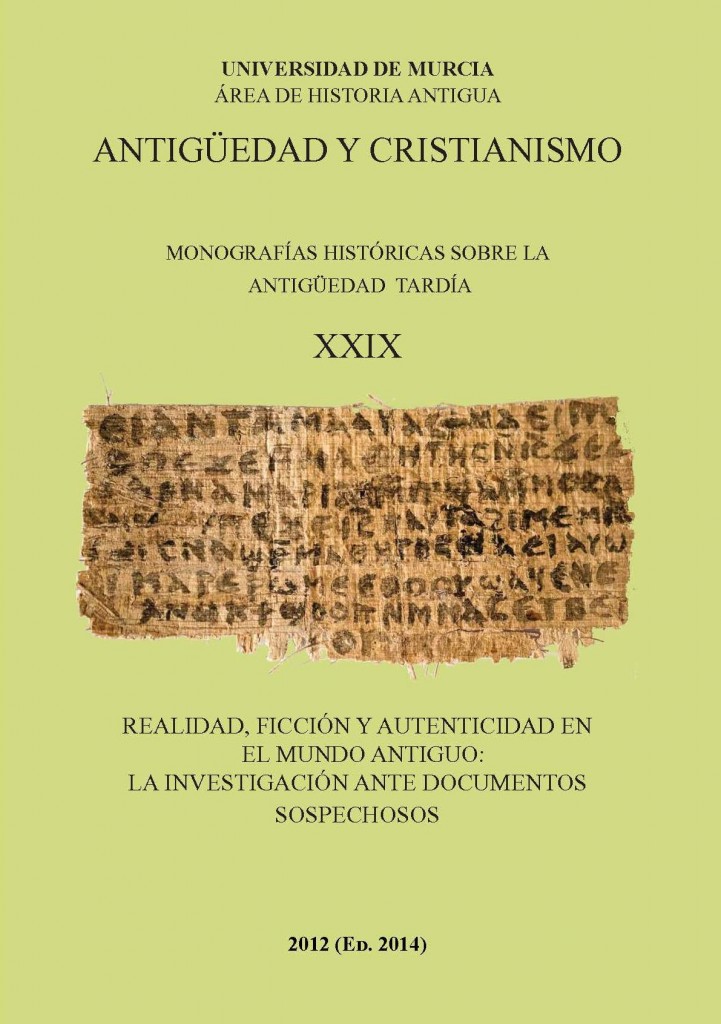The attraction of the false word and the forbidden code in Margaret Atwood: Nolite te bastardes carborundorum
Abstract
A false epigraph, found half hidden by a slave in a futuristic totalitarian regime, triggers the main leitmotif of a silent rebellion in Margaret Atwood's The Maid's Tale (1985). This is the way in which a background of social and cultural criticism and vindication is revealed through an inscription in Latin macaroni: Nolite tebastardes carborundorum. There are also other slogans and graffiti "read" by an author who, always interested in the traps and twists of language, plays with a certain frequency with the false literary epigraph.
Translated with www.DeepL.com/Translator (free version)
Downloads
-
Abstract605
-
PDF (Español (España))398
References
A. DAVIDSON, “Future Tense: Making History in The Handmaid’s Tale”, en K. Van Spanckeren-J. Garden (eds.), M. Atwood: Vision and Forms, Carbondale 1988, pp. 113–121
A. MALAK, “Margaret Atwood’s The Handmaid’s Tale and the Dystopian Tradition”, Canadian Literature 112 (1987), pp. 9–16
D. D. DODSON, “An Interview with M. Atwood,” Critique: Studies in Contemporary Fiction, 38, 2, 1997, p. 101
D. S. HOGSETTE, “Margaret Atwood’s Rhetorical Epilogue inThe Handmaid’s Tale: The Reader’s Role in Empowering Offred’s Speech Act”, Critique 38, 1997, pp. 262–78.
H. F. BERGMANN, ““Teaching Them to Read”: A Fishing Expedition in The Handmaid’s Tale”, College English 51, 8, 1989, pp. 847–854
J. W. GRAHAM (ed.), V. Woolf. The Waves: The Two Holograph Drafts, Londres 1976, p. 417
J.-P. PICOT, “Féminité et contre-utopie”, Les Cahiers du GRIF 47, 1993, p, 87
L. FEUER, “The Calculus of Love and Nightmare: The Handmaid’s Tale and the Dystopian Tradition”, Critique, 38:2, 1997, pp. 83–95.
L. HUNTER, “‘That Will Never Do’: Public History and Private Memory in Nineteen Eighty-Four and The Handmaid’s Tale”, en M. Dvorak (ed.), The Handmaid’s Tale: Margaret Atwood, París 1998, pp. 19–29.
L. M. YORK, “The Habits of Language: Uniform(ity), Transgression and Margaret Atwood”, Canadian Literature126, 1990, pp. 6–19
L. S. KAUFFMAN, Discourses of Desire: Gender, Genre, an Epistolary Fictions, Ithaca–Londres 1986
M. ATWOOD “An End to Audience”, The Dalhousie Review60, 1980, pp. 432
M. ATWOOD, “Genesis of The Handmaid’s Tale and Role of the Historical Notes”, en J.-M. Lacroix et al. (eds.), The Handmaid’s Tale, Roman Protéen, Ruén 1999, pp. 7–14; y “The Handmaid’s Tale and Oryx and Crake in Context”, PMLA 119.3, 2004, pp. 513–17
M. ATWOOD, “Witches”, en Second Words. Selected Critical Prose. Toronto 1982, p. 332
M. K. BOOKER, Dystopian Literature: A Theory and Research Guide, Westport 1994
M. LACOMBE, “The Writing on the Wall: Amputated Speech in Margaret Atwood’s The Handmaid’s Tale”, Wascana Review 21, 2, 1986, pp. 3–20
M. MAYER, “La técnica de producción de falsos epigráfi cos a través de algunos ejemplos de CIL II Excerpta Philologica 1, 2, 1991, pp. 491–499
T. FINIGAN, “’Into the Memory Hole’: Totalitarianism and Mal d’Archive in Nineteen Eighty-Four and The Handmaid’s Tale”, Science Fiction Studies 38, 3, 2011, pp. 435–459.
V. PROVENCAL, “Byzantine in the Extreme”: Plato’s Republic in The Handmaid’s Tale”, CML 19, 1, 1988, pp. 53–76
W. G. GARRETT-PETTS-D. LAWRENCE, Photographic Encounters. The edges and edginess of reading prose pictures and visual fi ctions, Edmonton – Kamloops, 2000
1. The authors non-exclusively assign the exploitation rights (reproduction, distribution, communication and transformation) to the magazine.
2. The works published in this magazine are subject to the Attribution-ShareAlike 4.0 International license (CC By SA 4.0). Therefore, they can be copied, used, disseminated, transmitted and publicly displayed, provided that:
i) the authorship and the original source of its publication (journal, editorial and URL of the work) are cited, thus allowing its recognition.
ii) it is allowed to remix, transform or create from the material while maintaining the same license as the original.
Note: Articles prior to 2022 incorrectly display the CC by SA license in the abstract page. They are under a CC by NC ND license as embedded in the article pdfs. Articles published in 2022 and after are under the CC by SA license.

3. Self-archiving conditions. Authors are allowed and encouraged to electronically disseminate the pre-print (version before being evaluated) and/or post-print (version evaluated and accepted for publication) versions of their works before publication, as it favors their publication. Earlier circulation and diffusion and with it a possible increase in its citation and reach among the academic community. Color RoMEO: verde.
























